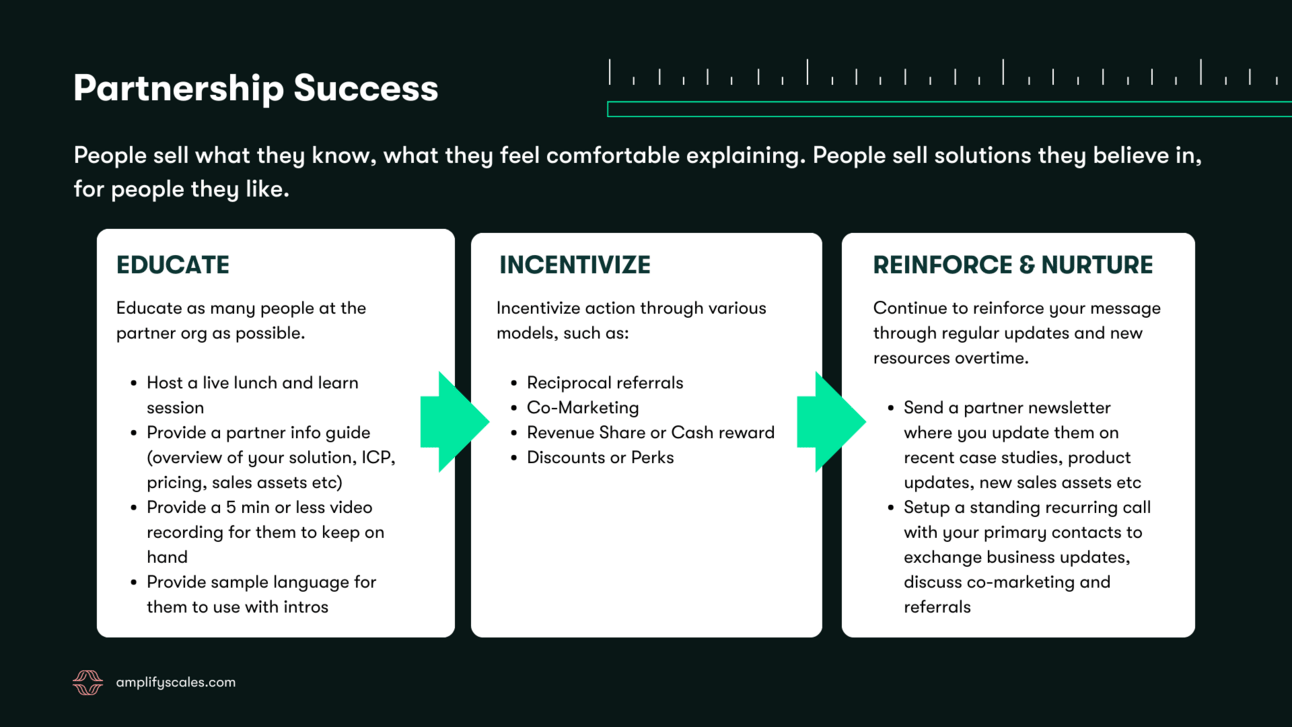Nearbound 101: Activating Partnerships
How to educate and incentivize your partners for action
Hi there - So far this month we’ve covered the types of B2B partnerships, how to build your target list, and engagement & discovery. This week, we’re going to cover how to activate your partnerships.
If we zoom out again, this is how I think about the activation process: Educate, Incentivize, Reinforce & Nurture.
Ok now let’s zoom in to each of these points.
How to activate your partnerships
#1 - Educate
People sell what they know. They sell what they feel comfortable explaining. So your first step is always going to be education.
For this, I like to create a couple assets + host a live session with the partner.
Assets -
A Partner Guide - a 7-10 page document that covers who your company is, your product or service, your ICP, your current customers, links to your top sales assets, details on pricing, any incentives (rev share etc), and sample intro language. Here is an example of one I made for a client.
A brief video overview (~5 mins) of you verbally explaining everything mentioned in #1. Why? Because not everyone reads…and hopefully if your video is interesting enough they will a) remember it, and/or b) feel inclined to open the partner guide after getting a quick preview of why they should care.
^These are assets your partners can use to learn more about your business and keep on hand for when the right opportunity arises.
Live Session -
Whenever possible, try to get a commitment to convene as many people as possible at the partner org on a live call (or a live meeting in person) to review the same materials. AND try to do this more than once, at least once a year so you continue to educate their new team members.
Having 10+ people at your partner org familiar with your offering is infinitely better than 1 person. And I see too many startups stop at 1 person. Educate as many people as they will let you. Offer for them to do the same with your team so it’s reciprocal.
#2 - Incentivize
We design compensation plans for sales reps to incentivize revenue results, and OKRs for our broader teams to tie compensation to results. The same concept can (and should) be applied to partners.
Your strongest levers are generally -
Reciprocal referrals
Co-Marketing (covered in more depth here)
Revenue share (%) or a fixed cash reward ($2,000/referral)
Discounts or perks (30% off, waived onboarding fee, 3 months free)
Which one(s) should you use?
Ask your partners. I like to create a two way dialogue on this and offer people options while soliciting their feedback on what they believe will incentivize their team the most. They know their team best.
Important to note here that the options mentioned above are not ‘pick one’ options. Partner A may be most incentivized by co-marketing, while Partner B chooses a Rev Share, and Partner C picks 2 of the 4. Mix and match to meet their needs and incentivize action.
Some additional tips on revenue share/cash rewards -
Revenue Share -
Generally I’ve seen 10-20% with SaaS products where margins are 80%+ and 5-15% for professional services where margins are lower.
Consider a tiered approach here too. For example, maybe your Tier 1 partners get 20% and Tier 2 get 15%. Maybe everyone can earn 20% AFTER they’ve made 10+ referrals in a calendar year.
Note: I’d always recommend you start simple so it’s easier to explain and manage. As you grow, you can get more detailed.
Cash is king. And I’ve seen more brands embracing a $2,000 fixed fee type reward for referrals versus a %. I really like this trend because 20% is hard for a lot of people to quantify…your next question is “20% of what?”.
Note: If you have a more complex / long sales cycle (3+ months), then a 2 or 3 pronged model can work well here too. For example, $500 per qualified lead AND another $1,000 for each closed won deal. If the referring party cares about cash as a reward, and it takes 3-6 months for them to reap any benefit…they might lose interest. Paying them for major milestones (first meeting, proposal, closed won) keeps them engaged.
For #2 - the same applies with discounts or perks. A $2,000 discount / credit towards your first invoice is easier to understand than 20% off.
#3 - Reinforce & Nurture
One of the most important things to remember is that this isn’t a ‘one and done’ or ‘check the box’ exercise. Your partners will need to be reminded 1) that you exist, 2) who you can help, 3) how you can help, and 4) why they should care. Over and over. Marketing 101 😀
Some of the best ways to reinforce and nurture include -
A Partner Specific Newsletter - A Quarterly or Monthly email with your latest product updates, events you’re attending, new case studies, new sales assets, and a reminder to use the Partner Guide. Pro tip - I love how HubSpot embeds a ~2-3 min video at the beginning of their partner newsletter.
A standing recurring call with your partners where you share mutual -
Business updates
Product updates
Review referrals received / given and discuss outcomes and updates
Co-marketing opportunities
Upcoming events or initiatives
For #2 above, I recommend segmenting your partners into Tier 1, 2, and 3 categories. Meet with your Tier 1 partners monthly, Tier 2 quarterly, and Tier 3 semi-annually. Define what it means to be Tier 1 v 2 the same way you define your ICP.
AND create an actual agenda for these meetings. Share that agenda with your partners a few days prior to your upcoming meetings so they can collaborate on the discussion points.
I hope this was helpful! If there are any topics you’d like me to cover in the coming months, feel free to send me a request.
Want to learn more about how I help startups increase their revenue by 150-590%? 👀
Know someone who could benefit from being added to this distribution? Send them here to sign up!
With love and gratitude -
If you want to learn more about working with me directly…
For B2B startups I serve as a Fractional GTM executive or advisor. Learn more about-
When you’re ready, let’s connect to discuss your specific growth goals and challenges.
Subscribe for weekly education, ideas, and frameworks
In this newsletter I share the exact tips, playbooks, and GTM multi-vitamins I’ve used to help 30+ B2B startups scale their revenue 150-590% YoY.
Thanks for reading GTM for Startups by Jess! This post is public so feel free to share it.



